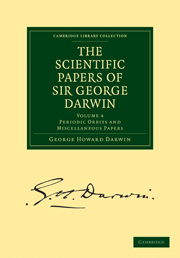Book contents
- Frontmatter
- PREFACE
- Contents
- Chronological List of Papers with References to the Volumes in which they are contained
- Errata
- PART I PERIODIC ORBITS
- PART II THE TIDES
- PART III MISCELLANEOUS PAPERS IN CHRONOLOGICAL ORDER
- 5 On some Proposed Forms of Slide-rule
- 6 An Application of Peaucellier's Cell
- 7 The Mechanical Description of Equipotential Lines
- 8 On a Mechanical Representation of the Second Elliptic Integral
- 9 On Maps of the World
- 10 A Geometrical Puzzle
- 11 A Geometrical Illustration of the Potential of a Distant Centre of Force
- 12 On Graphical Interpolation and Integration
- 13 On a Theorem in Spherical Harmonic Analysis
- 14 On Fallible Measures of Variable Quantities, and on the Treatment of Meteorological Observations
- 15 On the Horizontal Thrust of a Mass of Sand
- 16 On the Formation of Ripple-mark in Sand
- 17 Note on Mr Davison's Paper on the Straining of the Earth's Crust in Cooling
- 18 On the Mechanical Conditions of a Swarm of Meteorites, and on Theories of Cosmogony
- 19 On the Perturbation of a Comet in the Neighbourhood of a Planet
- 20 The Eulerian Nutation of the Earth's Axis
- 21 The Analogy between Lesage's Theory of Gravitation and the Repulsion of Light
- PART IV PAPERS ON TIDES (Supplementary to Volume I)
- PART V ADDRESSES TO SOCIETIES
- APPENDIX
- INDEX
- Plate section
20 - The Eulerian Nutation of the Earth's Axis
Published online by Cambridge University Press: 07 September 2010
- Frontmatter
- PREFACE
- Contents
- Chronological List of Papers with References to the Volumes in which they are contained
- Errata
- PART I PERIODIC ORBITS
- PART II THE TIDES
- PART III MISCELLANEOUS PAPERS IN CHRONOLOGICAL ORDER
- 5 On some Proposed Forms of Slide-rule
- 6 An Application of Peaucellier's Cell
- 7 The Mechanical Description of Equipotential Lines
- 8 On a Mechanical Representation of the Second Elliptic Integral
- 9 On Maps of the World
- 10 A Geometrical Puzzle
- 11 A Geometrical Illustration of the Potential of a Distant Centre of Force
- 12 On Graphical Interpolation and Integration
- 13 On a Theorem in Spherical Harmonic Analysis
- 14 On Fallible Measures of Variable Quantities, and on the Treatment of Meteorological Observations
- 15 On the Horizontal Thrust of a Mass of Sand
- 16 On the Formation of Ripple-mark in Sand
- 17 Note on Mr Davison's Paper on the Straining of the Earth's Crust in Cooling
- 18 On the Mechanical Conditions of a Swarm of Meteorites, and on Theories of Cosmogony
- 19 On the Perturbation of a Comet in the Neighbourhood of a Planet
- 20 The Eulerian Nutation of the Earth's Axis
- 21 The Analogy between Lesage's Theory of Gravitation and the Repulsion of Light
- PART IV PAPERS ON TIDES (Supplementary to Volume I)
- PART V ADDRESSES TO SOCIETIES
- APPENDIX
- INDEX
- Plate section
Summary
The latitude of any place is the mean of the altitudes of a star at its two transits above and below the pole, and the meridian is the great circle through the zenith bisecting the small circle described by a circumpolar star. Thus both the latitude and the meridian depend on the instantaneous axis of the earth's rotation, the observed latitude being the altitude of the instantaneous axis, and the meridian a great circle passing through that axis and the zenith of the place of observation.
But the meridian may also be taken to mean a great circle fixed in the earth passing through the geographical pole and the place. We may call these two circles the astronomical and geographical meridians. The relationship between the two meridians may be illustrated by a figure which I leave to the reader to draw for himself. If C be the geographical pole, I the instantaneous axis and P the place of observation, then IP is the astronomical meridian and CP the geographical meridian. The Eulerian nutation of an absolutely rigid earth would be such that I would describe a circle round C in a period of 306 days; if we allow the earth to yield elastically to centrifugal force the period of the circular motion is augmented and observation shows that the period of 306 days becomes one of about 430 days; lastly it appears that in actuality the simple circular motion is perturbed by other inequalities.
- Type
- Chapter
- Information
- The Scientific Papers of Sir George DarwinPeriodic Orbits and Miscellaneous Papers, pp. 437 - 445Publisher: Cambridge University PressPrint publication year: 2009First published in: 1911



